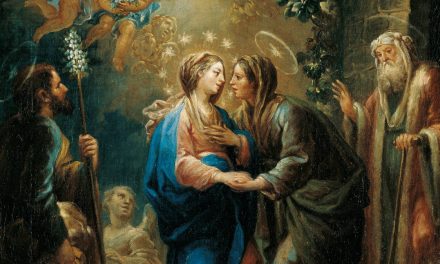Tomorrow, my Christmas tree comes down. Most people would call me a procrastinator or lazy. But it’s for neither of those reasons. It’s one way I can live liturgically.
The Christmas Season
The Christmas season, as I’ve mentioned here before, is one of the more confusing seasons to figure out. There is the octave of Christmas which lasts eight days, and during that time we celebrate each day as if it was a little Christmas. The Gloria is sung at Mass and if the Roman Canon is prayed (Eucharistic Prayer 1), the proper form of the Communicantes is used: “celebrating that most sacred night (day) on which blessed Mary the immaculate Virgin brought forth the Savior for this world, and in communion with those whose memory we venerate…” We celebrate Christmas day again and again. That octave culminates in the great solemnity of Mary, Holy Mother of God, which also celebrates the Jewish ritual of the child being named and circumcised on the eighth day of his life (Luke 2:21, Genesis 17:12).
Then there are the twelve days of Christmas, of course most well-known by the song—although most people probably believe they start on December 14. Those twelve days culminate in the great solemnity of Epiphany, which we know as the day that celebrates the visit of the magi to the Holy Family. Traditionally, Epiphany was also a celebration of other great manifestations of Jesus’ divinity, namely the Baptism by John and the Wedding at Cana. Many cultures still celebrate the Epiphany as most of us celebrate Christmas. It is the day for giving gifts.
The Christmas season actually ends, however, with the feast of the Baptism of the Lord, which in the current calendar the universal Church celebrates on the Sunday following Epiphany. (It gets confusing in the United States because we move the Epiphany to Sunday, so we occasionally have to celebrate the Baptism on the following Monday.)
First of all, if you don’t even want to read the rest of this post to see why my tree is still up, I’ll say this: keep your decorations up through the Christmas season. At the very least, keep them up through the twelve days of Christmas. What if my neighbor, Mrs. Heller, decided she was tired of her menorah on the third day of Hanukkah? Can you imagine? Aw, but it’s been up since November. I’m tired of the clutter. And yet that’s what the majority of people do with their Christmas decorations. Right in the middle of the Christmas celebrations, they throw their tree to the curb and put away their nativity set.
Christmastide
So why is my tree still up?
In an older tradition of the Church, there was a tradition to celebrate “Christmastide” until the feast of the Presentation of the Lord in the Temple, or Candlemas. While it’s not technically the Christmas season (that ends on the feast of the Baptism for both the Extraordinary Form and the General Roman calendar), there was still a sense of continuing to celebrate the joys of Christmas.
Practically, it gives me time to enjoy my Christmas tree since I travel for much of the Christmas season. Since I wait until close to Christmas to put up the tree (I put it up Gaudete Sunday), it is nice to keep it up during the dreary days of January. But most importantly, it just makes sense to keep celebrating after Epiphany. Take some time to contemplate the Incarnation. Sure, every feast can really be traced back to the love of God in the Incarnation. We celebrate the Incarnation on March 25, and we celebrate the reason for the Incarnation during the Triduum. But honestly, why the hurry to end Christmas? Easter lasts fifty days. Why only celebrate Christmas for 12 or at best, like this year, 19 days?
Now, I admit it. Keeping your tree up during Christmastide is not practical for most, especially if you have a live tree. I will point out that some people keep their live trees up for 40 days (the day after Thanksgiving to New Year’s Day, for example), and this is just adjusting those days to Christmas rather than Advent. But it’s not for everyone, and I totally understand that.
But even if you aren’t keeping your tree up, maybe your Nativity set? Maybe a garland of white lights on your mantle? Something small to remind you of the continued celebration of the birth of our Lord?
Even more than decorations, however, is our mindset. We should be ordering our lives to the mysteries of Christ’s life and the liturgical calendar. How can we order our mindset towards these mysteries? We, as human persons, need tangible reminders. Maybe it’s a Scripture verse posted in your home that you rotate according to the liturgical season. Or maybe it’s a certain prayer you pray, or certain artwork you use for meditation depending on the season.
Celebrate Candlemas
On February 2, we return once again to the Jewish rituals in Christ’s life and celebrate Joseph and Mary traveling to the Temple to observe the Law (see Leviticus 12:2-8, Ex 13:2,12). Even though Mary did not require purification and Jesus didn’t require redemption, they still obeyed the Law as observant Jews.
Along with the circumcision—the first time the blood of Christ was spilt for us—the Presentation is a reminder to us of the true Sacrifice entering the Old Covenant Temple to announce the New Covenant. The Lamb of God comes to the place where so many lambs had been offered and is presented to the priests. The perfect High Priest will offer Himself one day on Calvary, but His life of humble sacrifice and service begins here. Simeon recognizes this, and he proclaims that salvation has come for the world (Luke 2:29-32).
The Light has come. We celebrate this day by blessing candles which will be used in churches and homes throughout the year. It is a day of light, rejoicing, and salvation.
Since the day falls between the winter solstice and spring equinox, it has long been a day to predict the rest of winter. In England, an old tradition predicted that if the weather was beautiful, winter would come back. If the day was dreary, winter was almost over.
If Candlemas be fair and bright,
Come, Winter, have another flight.
If Candlemas brings clouds and rain,
Go, Winter, and come not again.
Sound familiar? Americans seemed to think introducing a groundhog into the equation would make more sense…
Candlemas so often gets lost in our lives, as just another day of the busy week. Don’t neglect it.
Find a way to introduce the liturgical season, the mysteries of Christ, and the celebrations of the Church year into your daily lives. Regardless of your state of life, there are ways to begin to re-insert a Christian culture into our homes. People’s lives used to revolve around these great feasts. Let us recapture this sense of the changing of liturgical seasons, the feasts and the fasts, and thus begin to order our lives by the eternity rather than mere temporal realities.
Ceremonies for Candlemas Eve
by Robert Herrick
Down with the rosemary and bays,
Down with the mistletoe;
Instead of holly, now up-raise
The greener box (for show).
The holly hitherto did sway;
Let box now domineer
Until the dancing Easter day,
Or Easter’s eve appear.
Then youthful box which now hath grace
Your houses to renew;
Grown old, surrender must his place
Unto the crisped yew.
When yew is out, then birch comes in,
And many flowers beside;
Both of a fresh and fragrant kin
To honour Whitsuntide.
Green rushes, then, and sweetest bents,
With cooler oaken boughs,
Come in for comely ornaments
To re-adorn the house.
Thus times do shift ; each thing his turn does hold ;
New things succeed, as former things grow old.















